This shop spent $100K to gain entry to Jaguar’s exclusive aluminum-repair network of authorized shops. While developing technologies from the world’s automakers have left most shops out in the cold, they also present risk-takers with some real opportunities.
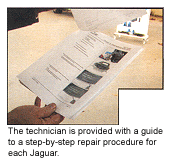
Fairless Hills, Pa. – Hunt Auto Body is at first glance, a typical independent body shop, tucked to the side of busy US Route 1 near the legendary Reedman dealership in Langhorne, once the world’s largest new car supermarket. But these days, Hunt Auto Body is facing major competition from a collision repair supermarket of its own kind – consolidators like Car Max, Sterling Auto Body and the Faulkner Collision Center (the largest dealership-group-owned body shop in Pennsylvania), all in the same neighborhood.
For Hunt’s owner, Mark Vettori, the writing was on the wall: Business as usual wasn’t going to cut it any longer.
The biggest problem in today’s body shop business is that there are too many qualified repair providers competing for a shrinking number of repairable cars (to say nothing of the unqualified repairers in the field). With all the low-end, entry-level vehicles on the market, such as the Chevy Aveo with an actual cash value closer to that of a gas grille than an automobile, we’re in an age of throwaway cars. Analysts are telling us the total loss frequency is climbing all the time, which has a net effect of giving the repair market less to work with. Add into this development a virtually unregulated business into which any person with an air compressor and a torch can gain entry, and you have a classic case of overcapacity.
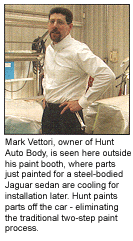
Despite some widely held beliefs to the contrary, the laws of supply and demand still control prices in this industry more than anything else. We see players like Hunt Auto Body swimming in a pool of competent shops that are, nonetheless, starved for a steady diet of collision repair work. And even though Hunt Auto Body always strived to be a cut better than its competition and worked hard for its customers’ loyalty, market share was slipping away steadily.
In an effort to stem the losses in market share by way of the DRP systems, Mark Vettori joined hands with the more militant body shops in the state to lobby for insurance claims reformation and the passage of new legislation. While his state’s organized efforts kicked up a lot of dust, no real substantive benefits were realized.
Meanwhile, Hunt’s customer base was eroding steadily.
“I haven’t seen a customer insured by Allstate in years,” says Vettori – a remarkable statement in light of the penetration that Allstate has in the Delaware Valley auto insurance market.
Faced with the reality that a good shop with good equipment, a well-trained staff and a good location was really nothing special in today’s business environment, Vettori knew he had to do some extraordinary things to be special – in other words, become a specialist.
“We wanted to be taken seriously,” he says.
Serious Investment
In order to be taken seriously, Vettori decided to became a Jaguar specialist. But to gain entry to the Jaguar aluminum repair network of authorized body shops, Vettori had to make a serious investment. Before that could happen, however, his shop had to be nominated by a Jaguar dealer. In the case of Hunt Auto Body, getting nominated was a little easier with their existing relationship with the Reedman organization, now Reedman-Toll.
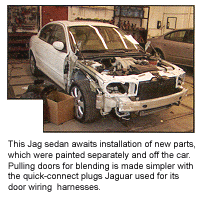
Once that hurdle was cleared, Hunt had to send its techs to the I-CAR Tech Centre in Appleton, Wis., for training in the specialty repairs to the aluminum-bodied cars. In preparation for this, I-CAR personnel attended a two-week Train-the-Trainer program conducted by Jaguar at a training centre in Nottingham, England, a year beforehand, where they were taught the ins and outs of the Al-Lou-Min-E-um repairs.
In their training, Hunt Auto Body’s techs and Vettori learned to work with the structural adhesives, the aluminum welders, the dedicated bench systems and the various specialty tools required for the straightening, removal and replacement of the aluminum panels.
The cost of becoming a member of the Jaguar authorized repair network is quite substantial. Hunt has invested well over $100K – and still counting. Is Vettori going to repair enough aluminum Jags to see a return on his investment? Probably, given the Ford acquisition of the Jaguar brand and sales figures. It’s certainly a gamble, but as they say, fortune favors the bold. Vettori is a little scared, to be sure, but it’s what you call a calculated risk. Don’t forget, there are other aluminum cars out there like the Audi and the AL front end BMWs. And more to come, to be sure.
Part of Vettori’s investment involves an equipment list that includes a specific dedicated bench, aluminum welder, self-piercing rivet gun and a slew of ancillary devices designed for the application of the bonding materials required to repair these cars.
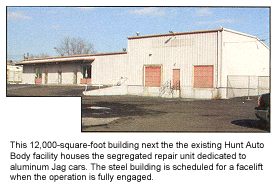
The investment in tools and equipment aside, aluminum repairs must be made in a segregated part of the shop or, preferably, in its own separate facility. This is done in order to prevent the cross contamination of steel and aluminum in the shops. Even a body hammer that was used on steel cannot be used on aluminum to prevent the galvanic corrosion process that occurs when dissimilar metals come in contact. Vettori said that even the bench has to be power washed before it holds an aluminum Jag if a steel car was held in its clamps.
Exclusivity
Exclusivity is guaranteed by Jaguar, which protects the shops that have made the investments. And only shops certified by Jaguar can purchase replacement parts from their dealers, and Celette and Global Jig, the only two equipment manufacturers in the certified Jag network, will not rent fixtures to non-certified body shops.
Dedicated benches, as you may recall, proliferated the repair market in the late ’70s and ’80s as unitized-bodied cars began to populate body shops. They were foolproof, but very cumbersome at the same time, often requiring the removal and reinstallation of suspension assemblies so that the fixtures (jigs) could be fitted beneath the strut towers and cross member mounting points.
As universal measuring systems – modeled after those sold with the legendary Car-O-Liner benches and later drive-on configurations sold by North American equipment manufacturers – gained quite a bit of popularity, dedicated benches began gathering dust in all but the serious specialty shops.
Aluminum Jag Claims…
State Farm Insurance Company is known as the bellwether in the claims business. That is, what they do is often the model for the rest of the property and casualty business. When asked what State Farm does differently when settling a claim on an insured aluminum XJ, their spokesperson Kip Diggs replied, “Nothing.”
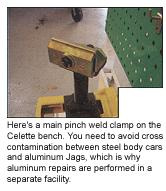
In a later conversation with Diggs, he elaborated on the response by saying, “We recognize the need for special handling of these cars, and we’re going to work with the repairer in these situations… Obviously PCP [prevailing competitive prices] won’t prevail in these claims.”
While State Farm and their approach can be characterized as consistent with respect to the claims process, it’s clear that the company is going to play this by ear in claims settlements. If the common retort of “we only pay the average of what area shops are charging” is what Hunt Auto Body will hear, State Farm might be hearing a very unfamiliar response: “No.”
What’s intriguing about the claims is the differentiation between structural and non-structural repairs. That is, will a company be forced to pay higher rates on cars with structural damage in terms of all the procedures performed? Or will they try to cherry pick the structural, pay the higher rate and then revert to the prevailing costs on the simpler rates that apply to the steel body cars within the same claim? The encouraging news is that whatever an insurance company would like to pay or do in one of these claims is not nearly as relevant as what a specialty shop like Hunt is willing to accept.
“I’m calling the shots,” says Vettori, in reference to his new approach to the claims settlement process. “I’ve got the backing of Jaguar, which is really nice.”
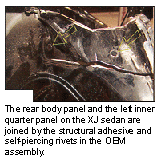
What’s also nice for Hunt Auto Body is that they can’t be harnessed to a right”onable labor database for collision repair procedures when performing a Jag repair. “It’s doubtful that any of the information providers have conducted labor time studies for these cars, so I override the book times and insert figures based on my knowledge and experience with the Jags,” says Vettori.
In an effort to verify Vettori’s assumption, I contacted CCC Information Services, the company that sells the estimating software to Hunt Auto Body. CCC’s spokesperson Michelle Hellyar responded with the following statement: “MOTOR is among the most accepted sources for labor times and parts prices in the industry. They use a combination of time surveys, manufacturer guidelines and other methods in compiling their data. CCC uses this data in its CCC Pathways Estimating Solution. Our software includes the ability for repairers to override labor and finishing times. When lines in an estimate are overridden, however, they are underlined and starred to indicate that changes have been made by the appraisal source – in this case, the repair facility. The acceptance of these changes then becomes a matter of discussion between the repairer and the insurance carrier of the damaged vehicle.”
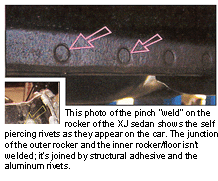
Market Repurcussions
What’s unique to these kinds of repairs is the reconstructive procedures used in the authorized Jaguar body shops are remarkably similar to those of the OE assembly. The same self-piercing rivets are used with the same type of structural adhesive, a process that approaches that elusive pre-loss condition target repairers have been aiming at for years. This time, however, the arrows are a lot closer to the bull’s eye than ever before possible – meaning less of a hit on resale value and better retention of that Jag-You-Are experience.
In its rather high stakes gamble, Hunt Auto Body has broken free of the yoke that’s essentially strangling U.S. body shops in terms of market pricing. They’ve done this by offering something different. The aluminum body repairs are truly a specialty, deserving a higher return on investment. Without disclosing their aluminum structural labor rate, it’s safe to say it’s more than double that of the run-of-the-mill repairs paid in the repair market.
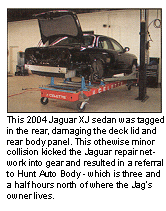
To illustrate how exclusive the Jaguar authorized repair shop network is, one of the cars in Hunt Auto Body that was damaged in Virginia was transported three and a half hours north to Fairless Hills, Pa. – the closest available Jaguar repair center. Just think of how many otherwise qualified body shops the transport passed along the way.
For those readers with an egalitarian bent, struck by the notion that an exclusive network like this isn’t fair to them, I’ll say this: Business isn’t fair, and it’s not meant to be. No one is entitled to customers or an equal share of the aluminum work. Jaguar will back those who’ve demonstrated they have what it takes and are willing to risk everything to be the best. Fairness aside, it would be a breach of an agreement for them to allow any qualified person in after the rest of the shops see how well Hunt Auto Body is doing. It’s unlikely that the thousands of area shop owners would’ve gambled their entire livelihood to be a Jaguar aluminum car shop. But Mark Vettori did.
The difference between this exclusionary arrangement and those favored by the insurance companies with their DRP networks is that the Jaguar network shops are truly better qualified, better equipped and better trained than the rest. These shops made the investments to become the best qualified in the marketplace. And unlike the insurer networks, which generally work to the lowest common denominator and award work to low bidders, the work in the Jaguar network flows to the qualified.
Instead of being sent to shops selected on the basis of how quickly their owners are willing to grab their ankles, the Jaguar drivers are directed to the cream of the crop.
Isn’t that how it should be?
Writer Charlie Barone has been working in and around the body shop business for more than 35 years, having owned and managed several collision repair shops. He’s an ASE Master Certified technician, a licensed damage appraiser and has been writing technical, management and opinion pieces since 1993. Barone can be reached at [email protected].
Comments? E-mail them to BSB editor Georgina K. Carson at
[email protected]













